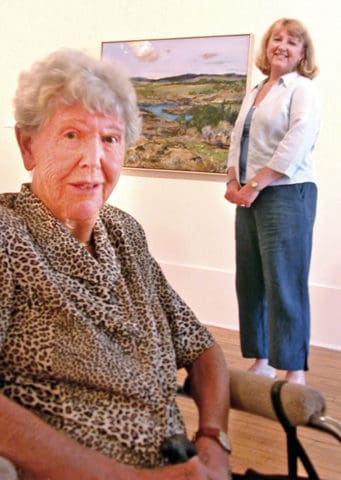In a lifetime, one can only aspire to live as passionately as Wynona Mulcaster did in her 101 years.
In 1915, Mulcaster was born in Prince Albert, Sask., where she continued to live until the late 1970s. Influenced by her love of horses and the prairies, she took her first art class at the age of 17 where she learned to paint.

Wynona Mulcaster (left) and Kenderdine campus director Kate Hobin enjoy a recent exhibition of Mulcaster’s work.
Mulcaster then continued her art education at the University of Saskatchewan, where she earned her bachelor of arts in 1943. During her time at the U of S, she had the opportunity to work with many artists, such as Ernest Lindner, who also acted as a mentor to Mulcaster.
Mulcaster did not stick within the Saskatchewan border to further her education in the arts, but enriched her artistic knowledge by studying at institutions across Canada and later, around the world. In the mid 1940s, a few years after graduating from the U of S, she moved to Alberta, where she studied at the Banff Centre for Arts and Creativity, and then enrolled at the School of Art and Design in Montreal, where she studied under Arthur Lismer.
The Saskatchewan artist became an influential figure teaching students across the province and sparking an interest in youth for the arts. She taught painting to children in Prince Albert and rural Saskatchewan for six years and continued her teaching at the Saskatchewan Teachers’ College the following year in 1947 in Saskatoon. During her years at the college, Mulcaster became the director of art education for three years from 1945 to 1948.
Mulcaster’s love of the arts led her to spread her knowledge and expertise beyond her position as an elementary teacher in Prince Albert and Saskatoon. At Emma Lake in 1937, Mulcaster attended a workshop where she became a mentor for the arts for nearly 56 years. Through her experience as a mentor and student, she worked with artists Joseph Plaskett, Will Barnett and Kenneth Noland, who both influenced and helped expand her work.
In 1964, Mulcaster was appointed as associate professor in the department of visual arts at the U of S. She held this position until 1977, where she taught notable artists such as Robert Murray, Otto Rogers and Allen Sapp.
In 1958, Mulcaster spent a year travelling across Europe studying abroad after receiving a Canada Council grant. In 1976, she received another grant from the Canada Council which took her to San Miguel de Allende, Mexico, where she received a master of fine arts at the world renowned Allende Institute.
Mulcaster is recognized as an extremely successful Saskatchewan artist — her art has been in many collections across Canada, in addition to her 32 solo exhibitions that displayed from 1954 to 2015 in various places across the world. In 1993, she received the revered Saskatchewan Arts Board Achievement for Excellence in the Arts award. Mulcaster’s success doesn’t just come from her paintings, but also from the influential and encouraging role she played to many aspiring artists in Saskatchewan.
The adventurous woman and pioneer of the arts will be remembered for her lasting legacy of art education and her ambition to explore it throughout the world. Because of Mulcaster, many Saskatchewan artists have followed the artistic path and now know that it’s a realistic and colorful career to pursue.
—
Lauren Klassen
Photo: Colleen MacPherson / Supplied